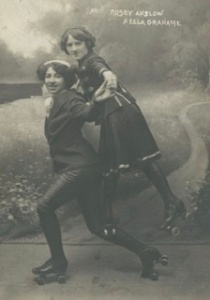The general population in the early 1900s was as susceptible to fashion and new-fangled ideas as we are today. The craze for roller-skating came over from America and swept the country. As ever, the music hall reflected life in the outside world and took the opportunity to bring new delights to its audiences. Roller-skating acts were soon included in music hall programmes and managers were encouraged to update the halls with flooring to accommodate skaters, or rinkers as they were known. As seen below, the suggestion seems to be that rinkers could use the halls for skating between performances and managers could cash in at the same time.

Specialist roller-skating rinks opened all over the country for the general public but were not universally popular among those already providing other forms of entertainment. In some areas publicans organised an anti-rinking campaign and billiard saloon owners met to discuss the way to combat the attraction of roller-skating. The trade paper, The Era, tells us that music halls seemed not to suffer a decline in trade and the manager of a large venue declared that skaters liked a quiet seat at an entertainment at least one evening a week. This may have been wishful thinking as Mr Alfred Graham, proprietor of the Hull Hippodrome and Middlesbrough’s Oxford Music Hall, was declared insolvent and blamed skating rinks for his troubles.
Health benefits were said to be gained from roller-skating with even the most  delicate people finding it beneficial. Headaches would become a thing of the past as the blood coursed more vigorously through the veins. Little is said about falls and broken limbs. Seeing the experts performing at rinks and music halls increased the popularity of the pastime with participants attempting dance steps and couple dancing, with mixed results.
delicate people finding it beneficial. Headaches would become a thing of the past as the blood coursed more vigorously through the veins. Little is said about falls and broken limbs. Seeing the experts performing at rinks and music halls increased the popularity of the pastime with participants attempting dance steps and couple dancing, with mixed results.
 Dolly Mitchell was a young Scottish roller-skater who teamed up with her American teacher, Harley Davidson, to give displays in rinks and music halls. Advertised as the greatest skaters in the world and giving a wonderful exhibition of trick, fancy, acrobatic, graceful and artistic skating. They displayed over £1,000 worth of gold and diamond medals won in competition. When appearing in Scarborough they cake-walked, two-stepped and waltzed on roller-skates before executing a perfect ballet dance. Harley Davidson described Dolly Mitchell as being sixteen years old, the daughter of a doctor in Aberdeen and the granddaughter of ‘old John Begg’ a whisky distiller. They visited London to have a portable maple floor made to fit any stage at a cost of £140 and Harley boasted they would be ‘the first roller-skating dancers and poseurs to travel with such a flooring’.
Dolly Mitchell was a young Scottish roller-skater who teamed up with her American teacher, Harley Davidson, to give displays in rinks and music halls. Advertised as the greatest skaters in the world and giving a wonderful exhibition of trick, fancy, acrobatic, graceful and artistic skating. They displayed over £1,000 worth of gold and diamond medals won in competition. When appearing in Scarborough they cake-walked, two-stepped and waltzed on roller-skates before executing a perfect ballet dance. Harley Davidson described Dolly Mitchell as being sixteen years old, the daughter of a doctor in Aberdeen and the granddaughter of ‘old John Begg’ a whisky distiller. They visited London to have a portable maple floor made to fit any stage at a cost of £140 and Harley boasted they would be ‘the first roller-skating dancers and poseurs to travel with such a flooring’.
Rosey Anslow and Ella Grahame were working in Poland  and had this publicity photo taken by Léo Forbert’s studio in Warsaw. Ella writes on the back of the card ‘What price this for swank. Do you like me in pants? The people can’t get past the size of my bottom here’. Let’s hope the audience appreciated their skill as well.
and had this publicity photo taken by Léo Forbert’s studio in Warsaw. Ella writes on the back of the card ‘What price this for swank. Do you like me in pants? The people can’t get past the size of my bottom here’. Let’s hope the audience appreciated their skill as well.
Information worth sharing is that Mr H. W. Izod, manager of a roller-skating rink in Earls Court London had, on two occasions, entered a wild beasts’ cage in public. The first time he played a game of ping-pong in the presence of eleven lions and the second time he shaved another man with fifteen lions around him. He was said to be a sworn enemy of monotony.
The rinking craze was short-lived and by 1911 many rinks had closed with investors losing considerable sums of money. However the music hall soldiered on.

Another interesting insight into an aspect of life on the Halls. Fascinating that Ella and Rosey ended up performing in Poland. Swank indeed!
LikeLike
Thanks, Alison. Looking forward to your talk. M
LikeLiked by 1 person